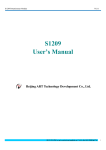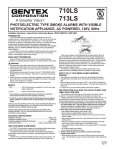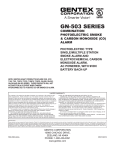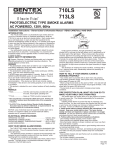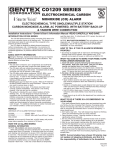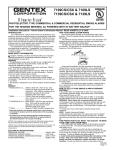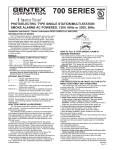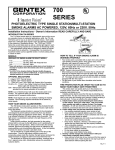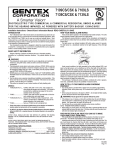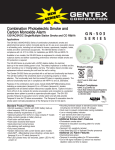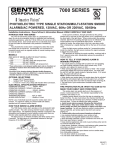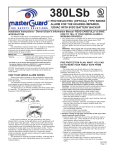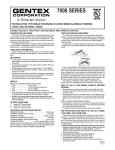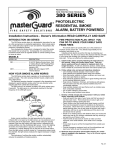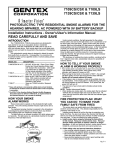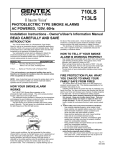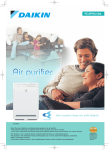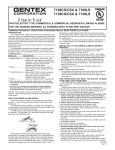Download Manual - Gentex Corporation
Transcript
S1209 SERIES PHOTOELECTRIC SMOKE ALARM PHOTOELECTRIC TYPE SINGLE/MULTIPLE STATION SMOKE ALARM, AC POWERED, WITH BATTERY BACK-UP & TANDEM WIRE CONNECTION Installation Instructions - Owner's/User’s Information Manual -READ CAREFULLY AND SAVE INTRODUCTION S1209 SERIES The S1209 Series photoelectric type smoke alarm for use as an evacuation device in all residential applications and as a supervisory alarm on a protected premises. The device has a solid state piezo signal to warn and alert the household to the presence of threatening smoke, as well as annunciate a trouble condition at the protected premises system. Your photoelectric smoke alarm is designed to detect the smoke that results from an actual fire. Consequently, it is uncommon for household smoke such as cigarette smoke or normal cooking smoke to cause an alarm. chamber, light from the pulsing LED light source is reflected by the smoke particles onto the photodiode light sensor. At the first sighting of smoke, the device is put into a pre-alarm mode. This is indicated by a rapidly flashing red LED on the face of the smoke alarm. Once the light sensor confirms smoke for 2 consecutive pulses inside the chamber, the light sensor produces the signal necessary to trigger the device and sound the electronic horn. BASIC SAFETY INFORMATION Dangers, Warnings, Cautions and Notices alert you to important operating procedures or to potentially hazardous situations. Pay special attention to these items. WARNING! This photoelectric smoke alarm is listed for use in single-family and multi-family residences, along with hotels, motels and other commercial residential occupancies. This photoelectric smoke alarm must receive continuous 120VAC, 60Hz , pure sine wave electrical power. (battery is meant for emergency back-up only). In order for the emergency battery backup to work, a new battery must be properly installed (see BATTERY INSTALLATION section). NEVER ignore your smoke alarm if it sounds. Refer to IF YOUR SMOKE ALARM SOUNDS section for more information. Failure to do so can result in serious injury or death. Test this device once a week per manufacturer installation recommendation. If the device ever fails to test correctly, replace immediately! If the device is not working properly, it can not alert you to a problem. This product is intended for use in indoor locations of family dwelling units. MODELS (SEE BACK OF SMOKE ALARM FOR EXACT MODEL) *S1209..........................120VAC, 60Hz with temporal horn * These units produce a temporal audible alarm for smoke alarm notification. Per NFPA 72, the American National Standard Audible Emergency Evacuation Signal as defined in ANSI S3.41, is required whenever the intended response is to evacuate the building. OPTIONS F - 1 Form A/1 Form C Auxiliary Relay ELECTRICAL SPECIFICATIONS OPERATING VOLTAGE. . . . . . . . . 120VAC, 60Hz OPERATING CURRENT. . . . . . . . . 0.045 amps OPERATING AMBIENT TEMPERATURE RANGE . . . . . . . 40OF to 100OF ALARM HORN RATING. . . . . . . . . 85dBA at 10 feet NOTICE: In the event AC Power fails, a 9VDC battery will provide proper alarm operation for a minimum of 24 hours. HOW THE SMOKE ALARM WORKS GENERAL INFORMATION - SMOKE ALARM The S1209 Series alarm operates on the photoelectric light scatter principle. The device’s sensing chamber houses a light source and a light sensor. The darkened sensing chamber is exposed to the atmosphere and designed to permit optimum smoke entry from any direction while rejecting light from outside the smoke alarm. The light source is an infrared (invisible) LED which pulses every 30 seconds to detect smoke. The light sensor is a photodiode matched to the light frequency of the LED light source. Under normal conditions, the light generated by the pulsing infrared LED is not seen by the light sensor, as it is positioned out of the direct path of the light beam. When smoke enters the sensing HOW TO TELL IF THE SMOKE ALARM IS WORKING PROPERLY Your device is provided with an alarm horn and flashing red Light Emitting Diode (LED) indicator, which flashes every 15-30 seconds, and a green AC power on LED. Test button function: when test button is pressed, the full operation of the light source, light sensor and smoke sensor circuit are verified and will initiate an alarm. If the battery is low or missing, a chirp will be emitted. If the smoke alarm is malfunctioning, two chirps will sound. If AC power fails, the green LED will turn off. NOTE: Tandem Interconnected Devices. When testing one device, the device that is activated will flash the red indicator light and sound its alarm horn. All other units will sound the alarm horn with their red indicator lights remaining off. FIRE PROTECTION PLAN: WHAT YOU CAN DO TO MAKE YOUR FAMILY SAFE FROM FIRES This smoke alarm can quickly alert you to the presence of smoke - it cannot prevent fire. The ultimate responsibility for fire protection rests solely on you. Installing smoke alarms is just the first step in protecting your family from fires. You also must reduce the chances that fires will start in your home and increase your chances of safely escaping if one does start. To have an effective fire safety program: a. Install smoke alarms properly following the instructions in this manual. Keep your units clean. Test your smoke alarm weekly and have unit repaired or replace unit when it no longer functions. As with any electronic product, smoke alarms have a limited life and devices that don't work cannot protect you. b. Follow safety rules and prevent hazardous situations: Use smoking materials properly; never smoke in bed. Keep matches and cigarette lighters away from children. Store flammable materials in proper containers and never use them near open flames or sparks. Keep electrical appliances and cords in good working order and do not overload electrical circuits. Keep stoves, fireplaces, chimneys, and barbecue grills greasefree and make sure they are properly installed away from combustible materials. Keep portable heaters and open flames such as candles away from combustible materials. Do not allow rubbish to accumulate. Do not leave small children home alone c. Develop a family escape plan and practice it with your entire family, especially small children. Draw and post a floor plan of your home and find two ways to exit from each room. There should be one way to get out of each bedroom without opening the door. 550-0008 Pg. S-1 Teach children what the smoke alarm signal means, and that they must be prepared to leave the residence by themselves if necessary. Show them how to check to see if doors are hot before opening them, how to stay close to the floor and crawl if necessary, and how to use the alternate exit if the door is hot and should not be opened. Decide on a meeting place a safe distance from your house and make sure that all your children understand that they should go and wait for you if there is a fire. Hold fire drills at least every 6 months to make sure that everyone, even small children, know what to do to escape safely. Know where to go to call the fire department from outside your residence. Provide emergency equipment such as fire extinguishers and teach your family to use this equipment properly. d. Bedroom doors should be closed while sleeping if a smoke alarm is installed in the bedroom. They act as a barrier against heat and smoke. WHAT TO DO IF THERE IS A FIRE IN YOUR HOME If you have prepared family escape plans and practiced them with your family, you have increased their chances of escaping safely. Review the following rules with your children when you have fire drills so everyone will remember them in a real fire emergency. If alarm should sound: a. Don't panic; stay calm. Your safe escape may depend on thinking clearly and remembering what you have practiced. b. Get out of the house following a planned escape route as quickly as possible. Do not stop to collect anything or to get dressed. c. Open doors carefully only after feeling to see if they are hot. Do not open a door if it is hot; use an alternate escape route. d. Stay close to the floor; smoke and hot gases rise. e. Cover your nose and mouth with a cloth, wet if possible, and take short, shallow breaths. f. Keep doors and windows closed unless you open them to escape. g. Meet at your prearranged meeting place after leaving the house. h. Call the Fire Department as soon as possible from outside your house. Give the address and your name. i. Never re-enter a burning building. Contact your local Fire Department for more information on making your home safer from fires and about preparing your family's escape plans. NOTE: Current studies have shown smoke alarms may not awaken all sleeping individuals, and that it is the responsibility of individuals in the household that are capable of assisting others to provide assistance to those who may not be awakened by the alarm sound, or to those who may be incapable of safely evacuating the area unassisted. WHAT THIS SMOKE ALARM CAN DO This smoke alarm is designed to sense smoke entering its sensing chamber. It does not sense heat or flames. When properly located, installed, and maintained, this smoke alarm is designed to provide early warning of developing fires at a reasonable cost. This device monitors the air and, when it senses smoke, activates its built-in alarm horn. It can provide precious time for you and your family to escape from your residence before a fire spreads. Such an early warning, however, is possible only if the smoke alarm is located, installed, and maintained as specified in this User's Manual. This smoke alarm is designed for use within single residential living units; that is, it should be used inside a single-family home or one apartment of a multi-family building. This smoke alarm can also be used with protection systems. In a multi-family building, the device may not provide early warning for residents if it is placed outside of the residential units, such as on outside porches, in corridors, lobbies, basements, or in other apartments. In multi-family buildings, each residential unit should have smoke alarms to alert the residents of that unit. Devices designed to be interconnected should be interconnected within one family residence only; otherwise, nuisance alarms will occur when a smoke alarm in another living unit is tested. NOTICE: WHAT SMOKE ALARMS CANNOT DO Smoke alarms will not work without power. A battery must be connected to the device to maintain proper operation if AC power supply is cut off by an electrical fire, an open fuse or circuit breaker, or for any other reason. In the event of AC power failure, the battery will supply power for a minimum of 24 hours. Smoke alarms may not sense fire that starts where smoke cannot reach the units such as in chimneys, in walls, on roofs, or on the other side of closed doors. If bedroom doors are usually closed at night, smoke alarms should be placed in each bedroom as well as in the common hallway between them. Smoke alarms also may not sense a fire on another level of a residence or building. For example, a second-floor device may not sense a first-floor or basement fire. Therefore, smoke alarms should be placed on every level of a residence or building. The horn in your device meets or exceeds current audibility requirements of Underwriters Laboratories. However, if the smoke alarm is located outside a bedroom, it may not wake up a sound sleeper, especially if the bedroom door is closed or only partly open. If the device is located on a different level of the residence than the bedroom, it is even less likely to awaken people sleeping in the bedroom. In such cases, the National Fire Protection Association recommends that the smoke alarms be interconnected so that a unit on any level of the residence will sound an alarm loud enough to awaken sleepers in closed bedrooms. This can be done by employing a systematic approach by interconnecting smoke alarms together, or by using radio frequency transmitters and receivers. All types of smoke alarm sensors have limitations. No type of device can sense every kind of fire every time. These types of fires include: 1) Fires where the victim is intimate with a flaming initiated fire; for example, when a person’s clothes catch on fire while cooking. 2) Fires where the smoke is prevented from reaching the smoke alarm due to a closed door or other obstruction. 3) Incendiary fires where the fire grows so rapidly that an occupant’s egress is blocked even with properly located smoke alarms. In general, smoke alarms may not always warn you about fires caused by violent explosions, escaping gas, improper storage of flammable materials, or arson. NOTICE: This smoke alarm is not designed to replace specialpurpose fire detection and alarm systems necessary to protect persons and property in non-residential buildings such as warehouses, or other large industrial or commercial buildings. It alone is not a suitable substitute for complete fire-detection systems designed to protect individuals in hotels and motels, dormitories, hospitals, or other health and supervisory care and retirement homes. Please refer to NFPA 101,The Life Safety Code, and NFPA 72 for smoke alarm requirements for fire protection in buildings not defined as "households." Installing smoke alarms may make you eligible for lower insurance rates, but smoke alarms are not a substitute for insurance. Home owners and renters should continue to insure their lives and property. NOTICE: GENERAL LIMITATIONS OF SMOKE ALARMS Smoke alarms may not awaken all individuals. If children and others do not readily awaken to the sound of the smoke alarm or if there are infants or family members with mobility limitations, make sure that someone is assigned to assist them in the event of an emergency. Smoke alarms will not work without power. This smoke alarm requires a continuous supply of power. Smoke alarms for solar or wind energy users and battery back-up power systems: AC powered smoke alarms should only be operated with true or pure sine wave inverters. Operating this device with most battery powered UPS (uninterruptible power supply) products or square wave or “quasi sine wave” inverters will damage the alarm. If you are not sure about your inverter or UPS type, please consult with the manufacturer to verify. Smoke alarms may not be heard. The alarm decibel rating meets or exceeds current UL Standards of 85dBA at 10 feet (3 meters). However if the device is installed outside the sleeping area, it may not awaken a sound sleeper, one who has recently used drugs or has been drinking alcoholic beverages. This is especially true if the door is closed or only partially open. Even persons who are awake may not hear the sounding alarm if the sound is blocked by distance or closed doors. Noise from traffic, stereo, radio, television, air conditioner, or other appliances may also prevent alert persons from hearing the alarm horn. This device is not intended for people who are hearing impaired. Smoke alarms have a limited life. Although the device and all of its components have passed many stringent tests and are designed to be as reliable as possible, any of these parts could fail at any time. Therefore, you must test your smoke alarm weekly. 550-0008 Pg. S-2 PLACEMENT OF SMOKE ALARMS THIS EQUIPMENT SHOULD BE INSTALLED IN ACCORDANCE WITH THE NATIONAL FIRE PROTECTION ASSOCIATION'S STANDARD 72 (National Fire Protection Association, Batterymarch Park, Quincy, MA 02269). For your information, the National Fire Protection Association's Standard 72, reads as follows: NFPA 72, 2010 Edition, Chapter 29, Section 29.5.1 Required Detection, states the following: 29.5.1.1 Where required by other governing laws, codes or standards for a specific type of occupancy, approved single and multiple-station smoke alarms shall be installed as follows: 1) In all sleeping rooms and guest rooms 2) Outside of each separate dwelling unit sleeping area, within 6.4m (21ft) of any door to a sleeping room, the distance measured along a path of travel 3) On every level of a dwelling unit, including basements 4) On every level of a residential board and care occupancy (small facility), including basements and excluding crawl spaces and unfinished attics 5) In the living area(s) of a guest suite 6) In the living area(s) of a residential board and care occupancy (small facility) 29.5.1.2 Where the area addressed in 29.5.1.1(2) is separated from the adjacent living areas by a door, a smoke alarm shall be installed in the area between the door and the sleeping room, and additional alarms shall be installed on the living area side of the door as specified by 29.5.1.1 and 29.5.1.3. 29.5.1.3 In addition to the requirements of 29.5.1.1(1) through 29.5.1.1(3), where the interior floor area for a given level of a dwelling unit, excluding garage areas, is greater than 93m2 (1000ft2), smoke alarms shall be installed per 29.5.1.3.1 and 29.5.1.3.2. 29.5.1.3.1 All points on the ceiling shall have a smoke alarm within a distance of 9.1m (30ft) travel distance or shall have an equivalent of one smoke alarm per 46m2 (500ft2) is evaluated by dividing the total interior square footage of floor area per level by 46m2 (500ft2). 29.5.1.3.2 Where dwelling units include great rooms or vaulted/ cathedral ceilings extending over multiple floors, smoke alarms located on the upper floor that are intended to protect the aforementioned area shall be permitted to be considered as part of the lower floor(s) protection scheme used to meet the requirements of 29.5.1.3.1. The installation of additional alarms of either the smoke, heat or CO type should result in a higher degree of protection. Adding alarms to rooms that are normally closed off from the required alarms increases the escape time because the fire does not need to build to the higher level necessary to force smoke out of the closed room to the required alarms. As a consequence, it is recommended that the householder consider the installation of additional fire protection devices. However, it should be understood that NFPA 72 does not require additional smoke alarms over and above those called for in Figures 1, 2, 3 and 4 where required smoke alarms are shown. Figure 1 Figure 1: A SMOKE ALARM MUST BE LOCATED ON EVERY LEVEL OF DWELLING UNIT, INCLUDING BASEMENT, WITHIN EACH SLEEPING ROOM AND OUTSIDE SLEEPING AREAS. Where to Locate the Required Smoke Alarms. The major threat from fire in a dwelling unit occurs at night when everyone is asleep. Persons in sleeping areas can be threatened by fires in the remainder of the unit; therefore, smoke alarms are best located in each bedroom and between the bedroom areas and the rest of the unit as shown in Figure 2. Figure 2 Figure 2: A SMOKE ALARM MUST BE LOCATED BETWEEN THE SLEEPING AREA AND THE REST OF THE DWELLING UNIT AS WELL AS IN EACH BEDROOM. In dwelling units with more than one bedroom area or with bedrooms on more than one floor, more than one smoke alarm is required, as shown in Figure 3. Figure 3 Figure 3: IN DWELLING UNITS WITH MORE THAN ONE SLEEPING AREA, A SMOKE ALARM MUST BE PROVIDED TO PROTECT EACH SLEEPING AREA IN ADDITION TO SMOKE ALARMS REQUIRED IN BEDROOMS. In addition to smoke alarms outside of the sleeping areas and in each bedroom, NFPA 72 requires the installation of a smoke alarm on each additional level of the dwelling unit, including the basement. These installations are shown in Figure 4. The living area smoke alarm should be installed in the living room or near the stairway to the upper lever, or in both locations. The basement smoke alarm should be installed in close proximity to the stairway leading to the floor above. Where installed on an open-joisted ceiling, the smoke alarm should be placed on the bottom of the joists. The smoke alarm should be positioned relative to the stairway so as to intercept smoke coming from a fire in the basement before the smoke enters the stairway. Figure 4 Figure 4: A SMOKE ALARM MUST BE LOCATED ON EACH LEVEL IN ADDITION TO EACH BEDROOM. IMPORTANT CONSIDERATION NFPA 72, 2010 Edition, Chapter 29, Section 29.8.1.45)(b) states: “Smoke alarms installed in one- and two-family dwellings shall not remain in service longer than 10 years from the date of manufacture.” Smoke alarms should be replaced for the following reasons: Dust, dirt, and other environmental contaminants can affect your smoke alarm over a prolonged period. Fast changing industry consensus standards and codes on all smoke alarms make it advisable to periodically upgrade your smoke alarm to maximize life safety. Assurance that your smoke alarm needs are kept abreast with the constantly improving electronic technology. Smoke alarms are recognized as one of the lowest cost ways to protect dwelling inhabitants against the danger of fire(s). It makes good common sense to periodically replace and update your smoke alarm that contributes so much to life safety. MOUNTING LOCATION This smoke alarm can be mounted on a ceiling or wall with equal efficiency in either location. Ceiling location - smoke alarm should be mounted as close as possible to the center of a hallway or room. Wall location - locate the top of the smoke alarm not more than 12 inches from the ceiling. Figure 5 Figure 5: RECOMMENDED SMOKE ALARM MOUNTING LOCATIONS Figures 1, 2, 3, & 4 are reprinted with permission from NFPA 72, National Fire Alarm Code®, Copyright ©2002, National Fire Protection Association, Quincy, MA 02169. This reprinted material is not the complete and official position of the National Fire Protection Association on the referenced subject which is represented only by the standard in its entirety. National Fire Alarm Code® and NFPA 72® are registered trade550-0008 marks of the National Fire Protection Association, Inc., Quincy, MA 02169. Pg. S-3 Figure 6 Figure 6: RECOMMENDED SMOKE ALARM LOCATION IN ROOMS WITH SLOPED, GABLED, OR PEAKED CEILINGS. The placement of the smoke alarm is critical if maximum speed of fire detection is desired. Thus, a logical location for a smoke alarm is the center of the ceiling. At this location, the device is closest to all areas of the room. WHERE ALARMS SHOULD BE INSTALLED IN MOBILE HOMES In mobile homes built after about 1978 that were designed and insulated to be energy-efficient, smoke/alarms should be installed as described in the section above. In older mobile homes that have little or no insulation compared to today's standards, uninsulated metal outside walls and roofs can transfer heat and cold from outdoors, making the air right next to them hotter or colder than the rest of the inside air. These layers of hotter or colder air can prevent smoke from reaching a smoke alarm. Therefore, install devices in such units only on inside walls, not more than 12 inches (10 and 30 cm) from the ceiling. If you are not sure about the insulation level in your mobile home, or if you notice that the walls or ceiling are unusually hot or cold, install the device on an inside wall. Minimum protection requires one smoke alarm as close to the sleeping area as possible. For better protection, install one device in each room, but first read the "LOCATIONS TO AVOID." LOCATIONS TO AVOID Nuisance alarms are caused by placing smoke alarms where they will not operate properly. To avoid nuisance alarms, do not place smoke alarms: In or near areas where combustion particles are normally present such as kitchens; in garages where there are particles of combustion in vehicle exhausts; near furnaces, hot water heaters, or gas space heaters. Install smoke alarms between 10 feet (3 meters) and 20 feet (6 meters) away from kitchens and other areas where combustion particles are normally present. In air streams passing by kitchens. Figure 7 shows how a smoke alarm can be exposed to combustion particles in normal air movement paths, and how to correct this situation. Figure 7 In damp or very humid areas, or next to bathrooms with showers. The moisture in humid air can enter the sensing chamber as water vapor, then cool and condense into droplets that cause a nuisance alarm. Install smoke alarms at least 36 inches (910mm) away from bathrooms. In very cold or very hot environments, or in unheated buildings or outdoor rooms, where the temperature can go below or above the operating range of the smoke alarm. Temperature limits for proper operation are 40° to 100°F (4.4° to 37.8°C). In very dusty or dirty areas. Dust and dirt can build up on the smoke alarm's sensing chamber and can make it overly sensitive, or block openings to the sensing chamber and keep the smoke alarm from sensing smoke. Near fresh air inlets, returns or excessively drafty areas. Air conditioners, heaters, fans, fresh air intakes and returns can drive smoke away from smoke alarms, making the devices less effective. In dead air spaces at the top of a peaked roof or in the corners between ceilings and walls. Dead air may prevent smoke from reaching a smoke alarm. See Figures 5 and 6 for recommended mounting locations. In insect-infested areas. If insects enter a smoke alarm's sensing chamber, they may cause a nuisance alarm. Get rid of the bugs before installing smoke alarms where bugs are a problem. Near fluorescent light fixtures. Electrical "noise" from nearby fluorescent light fixtures may cause a nuisance alarm. Install smoke alarms and fluorescent lights on separate electrical circuits. Never disconnect an AC smoke alarm to silence a nuisance alarm. Open a window or fan the air around the device to remove the smoke. The alarm will automatically turn off when the smoke in the air is completely gone. Do not stand close to the device. The sound produced by the smoke alarm is loud because it is designed to awaken you in an emergency. Prolonged exposure to the horn at a close distance may be harmful to your hearing. IMPORTANT SAFETY MESSAGES This smoke alarm is designed for use inside a single or multi-family dwelling. It is not meant to be used in common lobbies, hallways, or basements of multi-family buildings unless working alarms are also installed in each family living unit. Smoke alarms in common areas may not be heard from inside individual family living units. This smoke alarm is not a suitable substitute for complete detection systems in places which house many people like hotels or dormitories, unless a smoke alarm is also placed in each unit. DO NOT use this smoke alarm in warehouses, industrial or commercial buildings, special-purpose non-residential buildings or airplanes. This smoke alarm is specifically designed for residential use and may not provide adequate protection in non-residential applications. INSTALLATION S1209 SERIES NOTICE: New Construction: DO NOT attach smoke alarm head until AFTER sanding, painting, and other dust creating situations are finished and cleaned up. WIRING/GENERAL 1. Use ANSI/UL Listed cable with Class 1 insulation. 2. Observe local code requirements. Use box connector to anchor cable to outlet box. 3. Metal outlet boxes must be grounded to earth ground. 4. NOTICE: Use only Duracell MN 1604 battery with the S1209 Series smoke alarms. Available at many retail stores. Use brown/yellow wire to tandem interconnect S1209 Series alarms to additional S1209 Series, GN-503 Series and CO1209 Series. DO NOT USE RED/YELLOW TO INTERCONNECT S1209 SERIES, GN-503 SERIES AND CO1209 SERIES. If the red/yellow is used to interconnect the S1209 Series to additional S1209 Series, GN-503 Series and CO1209 Series, the units will not be tandem interconnected. The brown/yellow MUST be used. Turn off electricity to prevent SHOCK and damage to smoke alarm. Be sure the power line to the smoke alarm is not controlled by any on/off switch, or other type of switch, other than a fuse or circuit breaker. NOTICE: Ensure that all fluorescent lighting fixtures are properly grounded. NOTE: The wiring to be used shall be in accordance with the provisions of Article 210 of the National Electrical Code, NFPA 70. Wire installation should be performed only by a licensed electrician. MOUNTING OUTLET BOX Use a 2" x 3" switch box or a 4" square or octagon junction box. Mount a box for each smoke alarm. If wall mounting is desired, be sure the box screws are oriented to upper right and lower left corners. Be sure to use supplied Mounting Plate. WIRING ONE ALARM 1. Run a minimum of 16 gauge, 2-conductor cable, plus ground (3 wires) to the junction box from a power supply. Smoke alarms shall be connected to their own dedicated circuit. Use ANSI/UL Listed Class 1 wire. NOTE: The wiring to be used shall be in accordance with the provisions of Article 300.3(b) 210 of the National Electrical Code, ANSI/NFPA 70 as well as Article 210. 2. Make wire connections to the supplied plug-in connector as follows: black to black, white to white, and connect the ground wire to the metal outlet box. Figure 8 RED-YELLOW OR BROWN-YELLOW WIRE BLACK 3-WIRE CABLE AND GROUND 120VAC UNINSULATED WIRE EARTH GROUND FOR METAL BOXES ONLY WHITE 550-0008 Pg. S-4 NOTE: RED-YELLOW WIRE AND BROWN-YELLOW WIRE: The red-yellow wire and brown-yellow wire from the smoke alarm is for tandem connection only. DO NOT USE, AND DO NOT REMOVE INSULATION CAP UNLESS CONNECTING ANOTHER SMOKE ALARM, SMOKE/CO ALARM OR CO ALARM. Figure 9 WIRING TWO OR MORE ALARMS Tandem Installation NOTE: All smoke alarms in a tandem installation must be controlled by the same fuse or circuit breaker. Otherwise tandem units will not operate. Tandem will operate in the event of AC power failure if battery is connected to the smoke alarm. LIMITATIONS: A maximum of 12 smoke alarms (S1209) may be connected together. Do not exceed 125 feet between each device. Do not exceed 1125 feet between first and last smoke alarm. NOTE: A maximum of 12 smoke alarms of S1209 with the relay option (F) may be tandem interconnected. Wire used for interconnection shall be in accordance with article 760 of the latest edition of National Electrical Code (NFPA 70) and must not exceed a resistance of 10 ohms. Figure 10 LIMITATIONS: Maximum of 12 smoke alarms may be connected together. Do not exceed 125 feet between each smoke alarm. Do not exceed 1125 feet between the first and last smoke alarm. 1. Run a minimum of 16 gauge, 3-conductor cable, plus ground (4 wires) to the first junction box from a power supply and between all smoke alarms that are to be connected together. Use ANSI/UL Listed Class 1 wire. Power limited cable for multiple tandem connections are available at many commercial electrical retail stores. NOTE: When using both tandem connections, 4-conductor cable, plus ground (5 wires) will be used. 2. Make wire connections to the supplied plug-in connector as follows: black to black, white to white, 3rd conductor to the red/ yellow wire for legacy Gentex products or the brown/yellow wire for new. The red/yellow wire or brown/yellow wire should be stripped to make the connection. Connect ground wire between metal outlet boxes. Figure 11 WHITE RED-YELLOW BROWN-YELLOW WIRE BLACK 4-WIRE CABLE 120VAC No more than 6 Gentex LEGACY products with Form A/Form C contacts may be connected in tandem. All units connected in tandem MUST get their power from the same circuit, that is, all smoke alarms in tandem must be controlled by the same fuse or circuit breaker. After installation, to verify proper working conditions, all horns must sound in this system. When tandem interconnecting S1209 Series to additional S1209 Series, GN-503 Series or CO1209 Series and the smoke alarm horn sounds but are not synchronized and the CO horn does not sound the red/yellow wire has been used. Use brown/yellow wire. Use red/yellow wire to tandem interconnect S1209 alarms to Gentex legacy products. Legacy products include 9120/9123 Series, 7100/7103 Series, 710CS/713CS Series, 7109CS/7139CS Series, GN-200/GN-203 Series and GN-300/GN-303 Series. Use brown/yellow wire to tandem interconnect S1209 Series alarms to additional S1209 Series, GN-503 Series and CO1209 Series. If the red/yellow wire is used to interconnect the S1209 Series to additional S1209 Series, GN-503 Series and CO1209 Series, the units will not be tandem interconnected. The brown/yellow MUST be used. Do not tandem using both the red/yellow wire and brown/yellow wire. Only 1 tandem interconnect wire is needed between units. CAUTION: Failure to observe any of the conditions set forth may cause system malfunction and damage to the device. BATTERY INSTALLATION 1. Locate side mounted battery drawer. 2. Open battery drawer by firmly pulling on side lip, then sliding battery drawer open. 3. Insert battery into drawer, terminal side first. Take care to make sure the appropriate terminal is aligned correctly, (+) terminal on battery to (+) terminal on alarm metal contact and (-) terminal on battery to (-) terminal on the alarm metal contact. 4. Rotate battery into drawer and close drawer. Note: the battery drawer will not close if the battery is installed incorrectly. 5. Slide battery drawer shut until it is snapped into place. 6. Use only Duracell MN 1604 battery with the S1209 Series smoke alarm. Available at many retail stores. 7. Push test button to verify battery operation. NOTE: Units with battery back-up will not provide power or transmit an alarm to other AC only units in the event of an AC power failure. All battery back-up units in tandem with good batteries will operate normally during an AC power failure a minimum of 24 hours. Figure 12 MOUNTING: PLATE & SMOKE ALARM 1. Lace the connector through the provided mounting plate and secure the plate to the junction box. 2. Plug the wire connector into the smoke alarm base. Figure 13 4th UNINSULATED WIRE EARTH GROUND - FOR METAL BOXES ONLY NOTES ON TANDEM INTERCONNECTING MODELS DO NOT connect Gentex Smoke Alarms to other manufacturers' smoke alarms. A maximum of 18 compatible smoke, heat, CO and/or combination smoke/CO alarms may be interconnected. No more than 12 of the 18 can be smoke alarms per NFPA72 No more than 12 Gentex model S1209 or S1209F may be connected in tandem. 3. Place device up to mounting plate, rotating it clockwise until device firmly snap locks into place. Keep smoke alarm parallel to the mounting plate so tabs on plate seat correctly into device. 4. Remove dust-cover after all construction is complete. Dust-cover must be removed prior to power being supplied to the smoke alarm. If the dust-cover is not removed, operation of smoke alarm will be inhibited. 550-0008 Pg. S-5 Figure 14 POWER ON INDICATOR/ SMOKE INDICATOR PRESS AND RELEASE BUTTON FOR SELF TEST. PUSH BUTTON AND HOLD UNTIL DEVICE ALARMS FOR FUNCTIONAL TEST NOTE: Remove dust-cover before operating smoke alarm 5. Press and release button for self test feature. Results of test: Alarm is silent - Smoke Alarm is in good working condition 1 Chirp - Low battery. Replace battery following instructions in Battery Installation Section 2 Chirps - Smoke Alarm has become dirty or defective. Clean (refer to Maintenance Section) or warranty return. CHECKOUT & TROUBLESHOOTING 1. Supply house power to the smoke alarm, green indicator will be on. The red indicator light should flash approximately every 15-30 seconds, showing that unit is operating properly. 2. If red light is not flashing or the green LED is not on: a. Check that AC power is working. b. Check that the battery is installed. c. Push test button and hold until device alarms. Alarm will go into self test mode. d. Check the connector plug and wire connections. NOTE: Be sure you turn off power before checking wire connections. e. If the power supply and wiring check out, but the red light does not flash or the green LED is still off, return the unit to the manufacturer. See TO RETURN AN ALARM. 3. When powering up devices in a tandem installation and all the alarms sound immediately, inspect all devices for a solid green LED. Verify wiring of units, if wiring checks and problem remains, the devices with flashing red LED are the trouble units and should be replaced. 4. If smoke alarm becomes contaminated by excessive dust and can not be cleaned, avoid nuisance alarms by replacing device. MAINTENANCE DO NOT open smoke alarm for cleaning. IF SMOKE ALARM IS OPENED, PRODUCT WARRANTY BECOMES VOID. CAUTION: If the device does not work properly, do not try and fix it yourself. This will void your warranty. See "TO RETURN AN ALARM" for instructions to return smoke alarms that do not operate properly. DO NOT TRY TO FIX IT YOURSELF. Gentex recommends smoke alarms be tested a minimum of once a week. CAUTION: Never use an open flame of any kind to test your device. You may ignite and damage the smoke alarm as well as your home. The test feature of your smoke alarm accurately simulates smoke conditions and tests the device's functions as required by Underwriters Laboratories. NOTICE: Do not cover, tape, or otherwise block the openings of your smoke alarm. These openings are designed to allow air to pass through your smoke alarm, thus sampling the air around the smoke alarm. NOTICE: Smoke alarms are not to be used with detector guards unless the combination has been evaluated by a nationally recognized testing laboratory and found suitable for that purpose. FAILURE TO REGULARLY CLEAN THIS SMOKE ALARM WILL RESULT IN FALSE ALARMS. A BUILD UP OF DUST CREATES AN OBSCURATION THAT SIMULATES SMOKE. THIS MEANS THE UNIT WILL GO INTO ALARM WITHOUT A FIRE CONDITION. WEEKLY TESTING Press the test/reset button on the alarm until the alarm sounds. During testing the device will simulate a smoke condition in the alarm. LED’s will flash to indicate testing. The alarm sequence should last 10-20 seconds. If the device does not alarm, make sure it is fully operational. If the device still does not go into alarm mode when tested, replace the device immediately. If the alarm ever fails to test properly, replace it immediately. Products under warranty may be returned to the manufacturer for replacement, see “Limited Warranty.” DO NOT stand close to the device when the alarm is sounding. Exposure at close range could result in hearing damage. TO KEEP THE ALARM WORKING PROPERLY: Test weekly as described in “Weekly Testing.” Keep alarm cover clean using soft cloth. DO NOT vacuum or use compressed air, water, cleaners or solvents to clean alarm. Replace battery immediately if low battery warning is heard. See “Battery Installation” section. NOTICE: DO NOT spray cleaning chemicals or insect sprays directly on or near the alarm. DO NOT paint over the alarm. Doing so may cause permanent damage. Household cleaners, aerosol chemicals and other contaminants can affect the sensor. When using any of these materials near the alarm, make sure the room is well ventilated. This smoke alarm is not washable. DO NOT submerge the alarm in water. Water can affect the sensor, causing permanent damage. TO RETURN AN ALARM Should you experience problems with your smoke alarm, proceed as follows: 1. Turn off electrical power to the smoke alarm. 2. Twist the smoke alarm counter-clockwise to remove it from its mounting plate. 3. Unplug the connector from the back of the smoke alarm. Do not remove the wire connection; leave the connector for your replacement smoke alarm. 4. Remove battery from smoke alarm. Do not ship smoke alarm with battery still in battery drawer. 5. Carefully pack (the manufacturer cannot be responsible for consequential damage) and return to the manufacturer. Include complete details as to exact nature of difficulties being experienced and date of installation. 6. Return to: Gentex Corporation, 10985 Chicago Drive, Zeeland, Michigan 49464. Prior to returning, call Gentex at 800-436-8391 or e-mail [email protected] to obtain a RMA Number from our return department. LIMITED WARRANTY For a period of 12 months from the date of purchase, or a maximum of 18 months from the date of manufacture, Gentex warrants to you, the original consumer purchaser, that your Smoke Alarm will be free from defects in workmanship, materials, and construction under normal use and service. If a defect in workmanship, materials, or construction should cause your Smoke Alarm to become inoperable within the warranty period, Gentex will repair your Smoke Alarm or furnish you with a new or rebuilt replacement Smoke Alarm without charge to you except for postage required to return the Smoke Alarm to us. Your repaired or replacement Smoke Alarm will be returned to you free of charge and it will be covered under this warranty for the balance of the warranty period. This warranty is void if our inspection of your Smoke Alarm shows that the damage or failure was caused by abuse, misuse, abnormal usage, faulty installation, improper maintenance, or repairs other than those performed by us. ANY WARRANTIES IMPLIED UNDER ANY STATE LAW, INCLUDING IMPLIED WARRANTIES OF MERCHANTABILITY OR FITNESS FOR A PARTICULAR PURPOSE, APPLY ONLY FOR THE WARRANTY PERIOD SPECIFIED ABOVE. PLEASE NOTE THAT SOME STATES DO NOT ALLOW LIMITATIONS ON HOW LONG AN IMPLIED WARRANTY LASTS, SO THE ABOVE EXCLUSION MAY NOT APPLY TO YOU. GENTEX WILL NOT BE LIABLE FOR ANY LOSS, DAMAGE, INCIDENTAL OR CONSEQUENTIAL DAMAGES OF ANY KIND ARISING IN CONNECTION WITH THE SALE, USE, OR REPAIR OF THIS SMOKE ALARM. PLEASE NOTE THAT SOME STATES DO NOT ALLOW THE EXCLUSION OR LIMITATION OF INCIDENTAL OR CONSEQUENTIAL DAMAGES. SO THE ABOVE EXCLUSION MAY NOT APPLY TO YOU. If a defect in workmanship, materials, or construction should cause your Smoke Alarm to become inoperable within the warranty period, you must return the Smoke Alarm to Gentex postage prepaid. You must also pack the Smoke Alarm to minimize the risk of it being damaged in transit. You must also enclose a return address. Smoke Alarms returned for warranty service should be sent to: Gentex Corporation, 10985 Chicago Drive, Zeeland, MI 49464. If we receive a Smoke Alarm in a damaged condition as the result of shipping, we will notify you and you must file a claim with the Shipper. THIS LIMITED WARRANTY GIVES YOU SPECIFIC LEGAL RIGHTS. YOU MAY ALSO HAVE OTHER RIGHTS WHICH VARY FROM STATE TO STATE. Important Notice: These materials have been prepared by Gentex Corporation ("Gentex") for informational purposes only, are necessarily summary, and are not purported to serve as legal advice and should not be used as such. Gentex makes no representations and warranties, express or implied, that these materials are complete and accurate, up-to-date, or in compliance with all relevant local, state and federal laws, regulations and rules. The materials do not address all legal considerations as there is inevitable uncertainty regarding interpretation of laws, regulations and rules and the application of such laws, regulations and rules to particular fact patterns. Each person's activities can differently affect the obligations that exist under applicable laws, regulations or rules. Therefore, these materials should be used only for informational purposes and should not be used as a substitute for seeking professional legal advice. Gentex will not be responsible for any action or failure to act in reliance upon the information contained in this material. 550-0008-AAA GENTEX CORPORATION 10985 CHICAGO DRIVE, ZEELAND, MI 49464 PHONE: 1-800-436-8391 www.gentex.com 11-01-09 Pg. S-6







